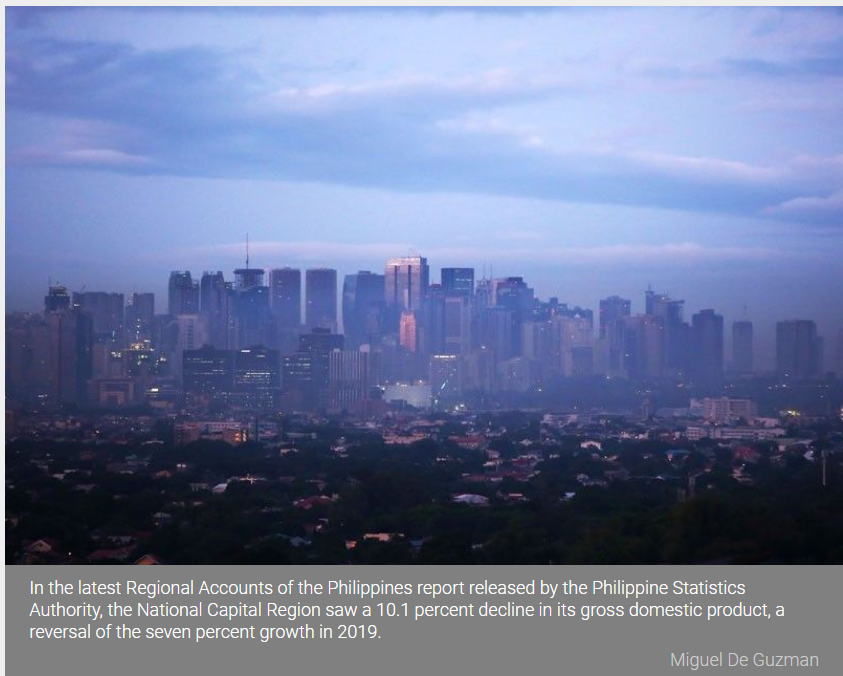Thailand: Lockdown sinks NCR economy deeper in 2020
MANILA, Philippines — Metro Manila, the main economic hub which became the epicenter of the COVID-19 outbreak in the country, suffered a 10.1 percent contraction in output last year as mobility restrictions took a toll on services crucial to growth.
In the latest Regional Accounts of the Philippines report released by the Philippine Statistics Authority (PSA), the National Capital Region saw a 10.1 percent decline in its gross domestic product (GDP), a reversal of the seven percent growth in 2019.
This was also way steeper than the 9.6 percent contraction of the national economy.
Metro Manila’s GDP went down to P5.6 trillion in 2020 from P6.2 trillion in 2019. It recorded the third highest contraction among the 17 regions in the country.
The capital took a beating from COVID-19 being the epicenter of the virus, prompting lockdowns and closure of various business establishments.
National Economic and Development Authority Assistant Secretary Greg Pineda attributed the decline to restrictions in economic activities last year.
“NCR has a crucial role. The restriction in the physical movement of people created job and income losses. Although NCR is services-led, manufacturing is also crucial in terms of value in total economic output,” Pineda said in a briefing.
“More than one-third of output is contributed by the NCR. It’s critical on how it will perform in the recovery pace as the national economy is dependent on the region,” he said.
Almost all industry sectors in NCR posted sharp declines last year, led by accommodation and food services at 52 percent. Reductions were also noted in transportation and storage, education and construction.
The only increments, and only at a minimum, were recorded in public administration and defense, financial and insurance activities, and information and communication.
On a per capita basis, the average contribution of an individual to regional GDP declined 11.2 percent to P405,399 per person from P456,532.
Household final consumption expenditure also dipped 9.6 percent to P216,824 from P239,835.
Apart from the pandemic, PSA-NCR regional director Paciano Dizon said other factors for the decline include the eruption of Taal in January 2020 and the consecutive typhoons at the tail end of last year.
Further, the PSA reported that all 17 regional economies were down in 2020 with Central Luzon posting the biggest drop at 13.9 percent followed by CALABARZON at 10.5 percent. NCR came in third with a 10.1 percent decline.
It should be noted that Central Luzon and CALABARZON are also COVID-19 hotspots being geographically close to Metro Manila. Several agriculture and manufacturing services are also situated in the two regions.
Other regions that sunk deeper than the Philippine economy last year include Cordillera, Cagayan Valley, and Central Visayas at 9.9 percent each, and Western Visayas at 9.7 percent.
Dizon said the cancellation of the conduct of events and festivities of heavily tourism-reliant regions such as the Panagbenga in Cordillera and the lack of tourists in top destination Boracay Island in Western Visayas all contributed to the decline.
“The partial and permanent closure of establishments that cannot sustain operating costs and the double digit unemployment rate in April and July last year all affected regional economies,” Dizon said.
He added that the continued outbreak of the African swine fever (ASF) was also a major factor. Central Luzon, which recorded the steepest decline, was the epicenter of the ASF outbreak since 2019.
More than half of the hog population in Central Luzon has already been decimated due to ASF.
Source: https://www.philstar.com/business/2021/04/30/2094703/lockdown-sinks-ncr-economy-deeper-2020


 English
English




